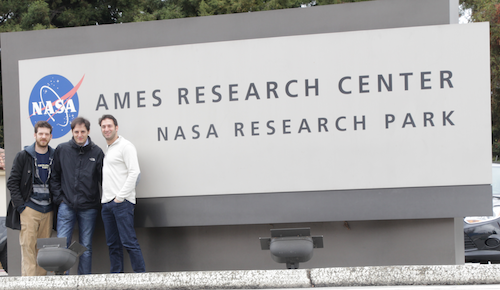The name “University” may be misleading.
“University” is reminiscent of classic, dusty and old insitution.
You couldn’t be more wrong.
The Singularity University is nothing conventional, it is not even a physical place. It’s a unique experience.
I got there after half an hour drive from the San Francisco airport and I was immediately catapulted into another world.
A large sign welcomes the alumni standing triumphant at the entrance where a logo makes you aware that you have entered another world: it is the NASA logo.
The campus covers a few square kilometers, an area where you can find objects and buildings, dating back to a few years ago, of some interest: hangar 1, bought by Google to easily park their private jets fleet; bombers of World War II; aircraft prototypes aircraft; buildings where are at work some of the most interesting startups in Silicon Valley.
The days are almost always held inside a building that houses the Singularity Classroom.
A room where, surrounded by 80-inch LCD screens, live webcams and drones, stands the question will bother us for this eight days experience and that, surely, will torment us once back at home:
“HOW WILL YOU IMPROVE THE LIVES OF A BILLION PEOPLE?”
The Singularity University is all here. 80 people from all over the world, who try to give an answer to this question.
Here we are not looking for a quick way to make money, you are not franticly searching for the next billion-dollar exit, here people want to change the world.
Changing the world seems to be the mantra by which everyone wakes up in the morning. It is the belief that drives people to get out of bed and to start their brain.
A high, very high, objective which makes us dizzy and that makes us feel small in our everyday lives.
One after another, the speakers take the stage and lead us to the discovery of what may – or with reasonable certainty will be – the world in 5 years.
They do not give us solutions, but stimuli. Small, continuous electroshocks, which push our neurons to give an answer to that question.
Genetics, 3D production, robotics, artificial intelligence and big datas are nothing more than practical tools to get to that answer.
Everyone is free to choose the best tool to try to answer the question.
Answering the question is not easy, so the experience will not end here.
Once back, we will become Singularity Alumni with the task of sharing the experience to make more and more people try to answer that question.
The most powerful computer in the world is, in fact, the network of human brains connected together to find an answer, a solution.
Not to solve a problem but to fulfill a mission: to improve the lives of 1 billion people.
Usually we are used to think in a vertical manner: there is a digital, robotics, artificial intelligence, genetics and all the other disciplines, old and new.
Singularity University gave us a different view.
These aspects of our future life are converging more and more towards a single point.
Genetics will be applied to industrial products, the creation of more powerful computers, to advertising. The ‘artificial intelligence system will help humans to overcome the barriers in understanding today’s complex data. The robots will not only perform strenuous tasks, but will enter into our body to heal the diseased cells.
Each of these disciplines will change the world and will be interconnected with the others.
It is tiring to get used to such a high vision. And it is also hard being able to imagine the steps that will take us well beyond.
We feel a sense of vertigo – and we’re almost scared – in front of these visions.
But there is one aspect that connects all these visions: their exponential factor.
We can no longer think in a linear way: we must do so exponentially. We need to aim higher, otherwise it’s not worth it. Now the question is: “Are we ready to fly so high?”
At Singularity University in the courses change every time there is a new class, about every three months, to keep up with the times and offer updated content.
This illustrates the exponential change we are experiencing for the first time and how fast it is required to adapt.
If it is true that each of us (in life and in work) has to deal with everyday life and its needs, we cannot stop from having something to aim higher: a dream, a vision.
In order to change the lives of 1 billion people, and therefore our own, we have to aim at the moon.
I do not know if I’m ready to aim so high, but I think there are many people ready to take the leap.
For them, and for the curious, I will try to summarize through my notes and without any pretense of completeness what I have seen and the stimuli that I received. Hopefully they may become stimuli for everyone.
In this way, I hope, the network of people will work as the most powerful supercomputers, and our common energies will be brought to a common factor, that we wake up with the desire to change the world.

